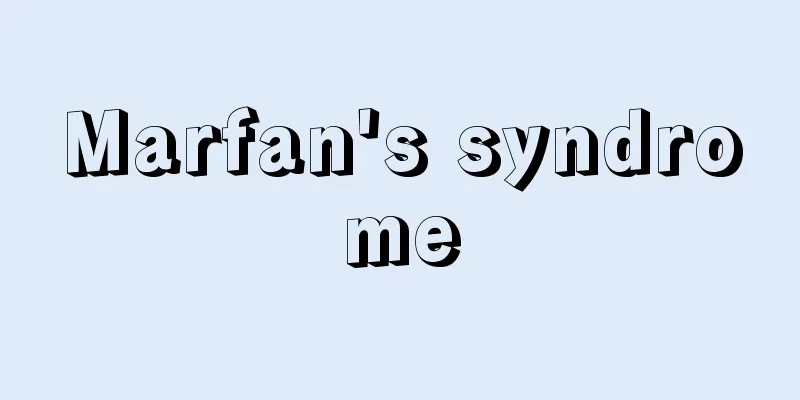Marfan's syndrome

What is the disease?Marfan syndrome is a hereditary disease that, in addition to physical characteristics such as a tall figure with long, slender limbs and fingers, and deformities of the spine and chest, can also present serious symptoms such as a dislocated lens in the eye (lens subluxation), a balloon-like bulge at the base of the aorta just after leaving the heart (aortic aneurysm), and separation of the aortic blood vessel wall into its two layers, the intima and adventitia (aortic dissection). It is seen in about 1 in 5,000 people. It is inherited from parent to child with a 50% probability regardless of gender (autosomal dominant inheritance), but the appearance and severity of symptoms vary between parents and children. There are various symptoms, but among them, aortic lesions are almost symptomless until dissection occurs, but once dissection occurs, it can be life-threatening, so special attention is required. Marfan syndrome type 2, which has strong vascular symptoms and is not accompanied by lens subluxation, has recently been classified as Loeys-Dietz syndrome. Loeys-Dietz syndrome is an autosomal dominant disease that shows characteristic vascular, skeletal, and cutaneous symptoms and is inherited by the TGF-β receptor. What is the cause? There is a congenital disorder of a molecule called fibrillin, which is one of the components of connective tissue that forms the framework of bones, muscles, blood vessels, skin, etc. throughout the body. This is due to an abnormality in the DNA sequence of the fibrillin 1 gene. In 75% of cases, the genetic abnormality is inherited from a parent, but in 25% the abnormality is the result of a mutation that occurs when sperm or eggs are produced. How symptoms manifestSymptoms appear in the skeleton, eyes, aorta, and skin, but the symptoms vary greatly from person to person. In rare cases, respiratory problems and decreased muscle tone may appear immediately after birth, but most infants will develop tall stature, long limbs, slender fingers, and soft joints. In some cases, symptoms such as double vision or difficulty seeing may appear due to subluxation of the lens. Other issues include myopia, astigmatism, and spinal Testing and diagnosisA comprehensive diagnosis is made in accordance with the international diagnostic criteria known as the Ghent Criteria, using physical findings (physical examination by a doctor), family history, as well as skeletal X-rays, cardiovascular ultrasound, ophthalmological examinations, chest and abdominal CT scans, and MRI scans. However, caution is required as aortic disease may be present even if the diagnostic criteria are not met. Genetic testing is available at some institutions. Treatment methods The most important thing is to manage the heart and aorta. If the aortic root dilatation progresses or leads to aortic dissection, surgery is performed to replace the aorta with an artificial blood vessel or valve. Blood pressure must also be controlled with antihypertensive drugs. For spine and chest deformities, What to do if you notice an illnessSince this is a disease that varies greatly from person to person, you will need to consult with your doctor and manage your lifestyle according to your individual symptoms. In general, it is recommended that you avoid activities that increase blood pressure and sports that involve a lot of hitting of the body or head. The departments that will be visited include pediatrics, orthopedics, ophthalmology, cardiology, and genetics. Yuko Morisaki Marfan syndrome |
どんな病気かマルファン症候群は、背が高く細長い手足と指、背骨や胸の変形といった体型的な特徴のほかに、眼のレンズがずれる(水晶体亜脱臼(あだっきゅう))、心臓を出てすぐの大動脈のつけ根の部分が風船のようにふくらんでこぶ状になる(大動脈瘤(りゅう))、大動脈の血管壁が内膜と外膜の2層にはがれる(大動脈解離(かいり))、といった重篤な症状を呈することもある、遺伝性の病気です。 約5000人に1人にみられます。性別に関係なく親から子へ50%の確率で遺伝(常染色体優性遺伝)しますが、症状の現れ方や程度には親子でも差があります。多彩な症状を認めますが、なかでも大動脈の病変は、解離を起こすまで自覚症状はほとんどありませんが、いったん解離すると命に関わるので、とくに注意が必要です。 血管系の症状が強く、水晶体亜脱臼を伴わない2型マルファン症候群は、最近、ロイス・ディーツ症候群として分類されています。ロイス・ディーツ症候群は血管・骨格・皮膚等に特徴的な症状を呈し、常染色体優性遺伝をする病気で、TGF 原因は何か 全身の骨、筋肉、血管、皮膚などの枠組みを作っている結合組織の成分のひとつである、フィブリリンという分子に生まれつき障害があります。これは、フィブリリン1という遺伝子のDNA配列に異常があるために、フィブリリン この遺伝子異常は、患者の75%では親から受け継いだものですが、25%では精子あるいは卵子が作られる時に生じた突然変異によるものです。 症状の現れ方骨格・眼・大動脈・皮膚などに症状が現れますが、症状の個人差が非常に大きい病気です。生まれてすぐに呼吸障害や筋緊張低下がみられることも、まれにありますが、多くは、幼児期から高身長、長い手足と細長い指、柔らかい関節を認めるようになります。水晶体亜脱臼のために、ものが二重に見えたり、見にくくなったりする症状が出る場合もあります。 その他、近視・乱視、背骨の 検査と診断理学的所見(医師による診察)や家族歴に加え、骨格系のX線検査、心臓血管超音波検査、眼科的検査、胸腹部CT検査、MRI検査などにより、ゲント基準と呼ばれる国際的診断基準にしたがって総合的に診断します。 ただし、診断基準を満たしていなくても大動脈病変がみられることがあるので、注意が必要です。遺伝子検査は一部の機関で行われています。 治療の方法 心臓や大動脈の管理が最も重要で、大動脈基部拡張が進行したり大動脈解離に至った場合は、人工血管や人工弁に取り替える手術を行います。また、降圧薬で血圧をコントロールする必要があります。背骨や胸の変形に対しては、必要に応じて 病気に気づいたらどうする個人差が大きい病気なので、個々の症状に合わせて、主治医と相談しながら生活管理をしていく必要があります。一般的には、血圧を上げる動作や、身体や頭をぶつけることの多いスポーツを避けることがすすめられます。 受診する科目としては、小児科、整形外科、眼科、循環器科、遺伝科となります。 森崎 裕子 マルファン症候群
|
>>: Malpighian tubes - marupigikan
Recommend
Engobe - Engobe
… Once the pottery's shape is roughly complet...
Schrebergärten (English spelling)
...For example, the Russian dacha is a small vill...
Kappa roll - Kappa roll
… There are various types of sushi rolls, such as...
Home industry - Kanai Kougyou
Despite mass production aimed at the market, this...
Takatora Todo
Year of death: 5th October 1630 (9th November 1630...
island shelf
… slope continental slope — island slope — the sl...
Lamartine
French poet and politician. Born into an aristocra...
Peter Pan
The protagonist of the play of the same name (firs...
Fishing pond - Tsuribori
〘 noun 〙 A place where fish are released and peopl...
Kaikosha - Kaikosha
It was founded in February 1877 (Meiji 10) as an ...
Retina - Momaku (English spelling)
The retina is the innermost membrane of the eyeba...
Ooyukinohana - Ooyukinohana
...Among spring-flowering bulbous plants, this is...
maxilla
The maxilla is a pair of bones located in the upp...
Grand Bahama Island
An island about 100 km off the coast of the Florid...
Syriac - Syriac
A language belonging to the Eastern Aramaic langua...









